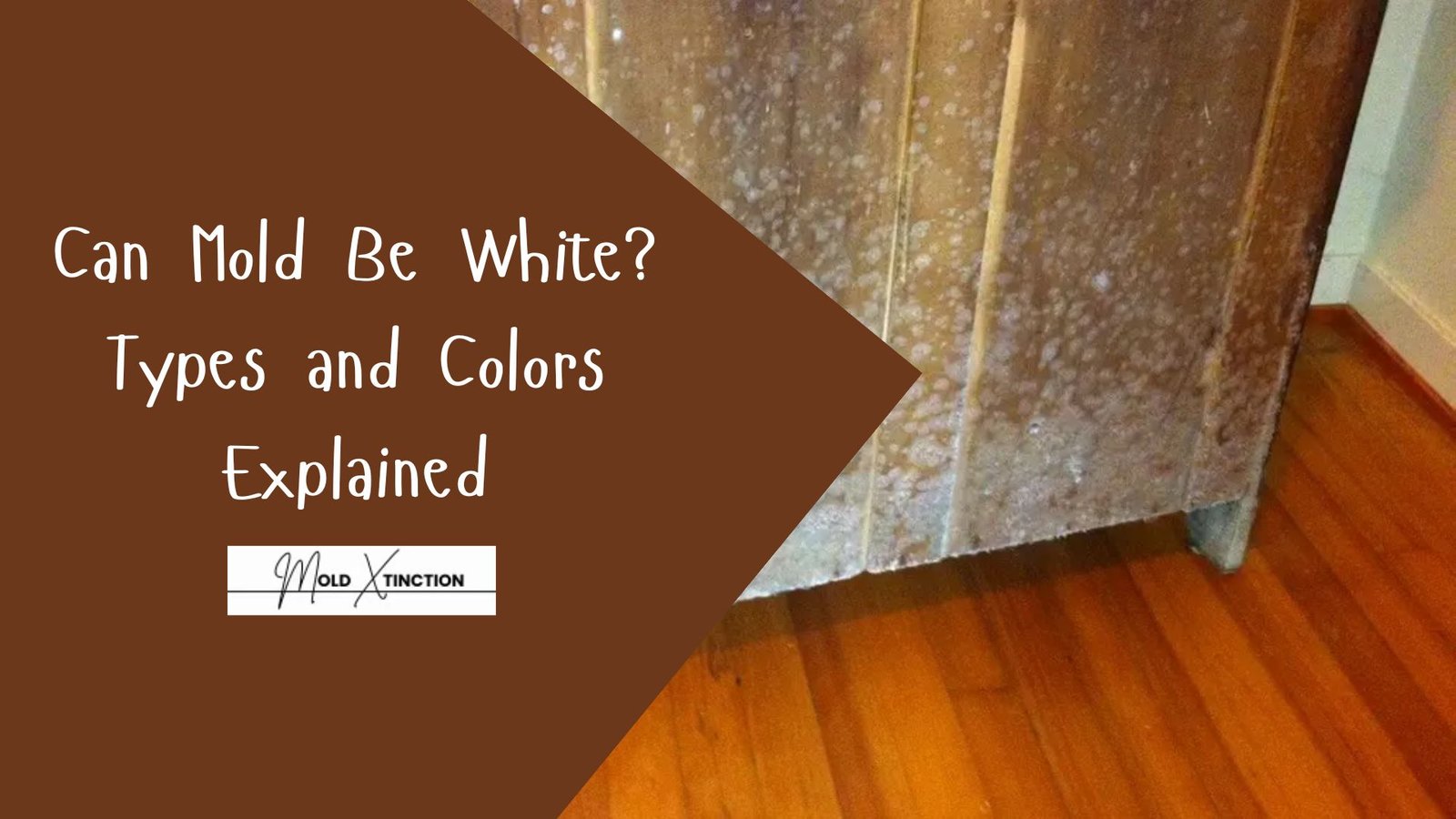Can Mold Be White? Types and colors explained carefully to guide you and your family to stay mold-free.
Not all molds are dark in color. Many individuals who are not really aware of this always feel it has one specific color. Some are green, some are yellow, some are brown, and then some are white and other colors.
White mold is more common than you think. White mold can grow in your house without you noticing it at all until you find it later on.
It can look like dust or chalk but it can still cause damage to your house and your health as well. The thing is many people overlook it until it becomes a big problem
The question was – can mold be white? In this article, we will answer that question and also tell you what white mold looks like, where it usually grows, how dangerous they are, and what you can do to prevent white mold in your home.
What's In This Article
ToggleCan Mold Be White? Types and Colors Explained

Yes, mold can be white. In fact white mold is one of the most sneaky you can get in your house. It can be mistaken with simple things like dust, flour, chalk and even salt.
But it’s dangerous not to pay attention to it White mold can look very casual, soft and light and yet it can penetrate very deep into any material and develop without being seen. It usually grows on wood, dry wall, ceiling, furniture and cloth.
It’s not always emitting a strong odor and can dissolve into the light colored surfaces. Eventually it can cause severe damage to your house as well as to your health if not eliminated properly.
What Does White Mold Look Like?
White mold appears as:
- Cottonish or fuzzy spots
- Powdery layers
- Thin/silky film
It can look chalky at times
On the surface it’s often mistaken by people with:
- Dust
- Flour
- Mildew
- Salt deposits
The thing is however. White mold will definitely be present whenever you wipe it out and it comes back or when it smells musty.
When in doubt always ask a professional to check it out.
Where Does White Mold Grow?
White mold grows where the temperature is not good and not well ventilated due to moisture and humidity. This is where water stays for long periods and this is the perfect condition for mold to grow and thrive. And it usually shows up in dark corners where there is no good air circulation and no sunlight penetrates.
These are in such areas as:
- Crawlspaces and basements
- Bad airflow in attics
- bathrooms with no windows or fans
- laundry rooms
- clothes closets of wet clothes
- I have walls, wallpaper, behind.
- On furniture or books or boxes laid in moist places
White mold too likes to grow on wood especially when the wood is not treated or raw like beams and shelves, floor boards.
When you keep goods in cardboard boxes on a concrete floor, make regular checks. That white mould thrives in dark and hidden spaces.
Is White Mold harmful?
White mold is harmful too, just the same as black, yellow or green ones. It is, lots of folks tend to forget just because it is not as spooky and colored. It is soft and light colored, therefore, apparently less of a threat which is a big mistake.
White mold may not give the impression that it could be severe and yet, it will result to coughing, sneezing, rashes on the skin and even breathing problems.
It can also ruin your walls, furniture and wooden constructions in the long run. White mold is not very friendly as you might think, and should be treated like every other mold.
Do they Cause Any Harm to one’s Health Risks?
Yes, they do, and here they are:
- Incessant cough and frequent sneezing
- Stuffy or nosebleed nose
- Itchiness of eyes or skin
- Dizziness or headache
- Asthma attacks among asthmatic persons
- Fatigue and shortness of breath
Although you may not be allergic, exposure to mold spores will sicken you in time. Most susceptible are babies, elderly individuals and people with compromised immunity.
Destruction of Your House:
White mold can:
- Damage drywall and wood Weaken wood
- Leave stains
- Destroy clothes, books or any furniture
- Produce bad odours
- Reduce the value of your house
- The longer it stays, the worse it gets.
Other Mold Colors and What They Mean
Mold doesn’t have a single color and that’s a surprise to many. Some molds have a smooth texture, some have an orange color and some others have a rough appearance. Although the type can be acquired remotely through color, all molds are hazardous and should be addressed.
1. Black Mold
- dusky greenish-black
- Lyme disease is usually transmitted in secluded wet places
- Is dangerous to humans
- Shares the same common on drywall, wood and carpets
- Demands immediate professional assistance
2. Green Mold
- Seen on food, bathroom walls and the corners of the showers
- May seem slimy or furry
- May cause allergies
Areas prone to condensation are often found in humid kitchens and in the laundry areas
3. Yellow Mold
- Sticky and slimy
- On walls, insulation, and BM
- Grows fast and can destroy surfaces
- No one should ignore this
4. Blue Mold
- Most times it is seen growing on foods such as bread or cheese
- Can also be put on walls or ceiling tiles
- May cause infections or breathing difficulties
5. Pink Mold
- Bathrooms must have them in common
- Can be found on tiles, shower curtains or sinks
- Technically a bacteria, but causes a mold like problem
- May cause skin and eye complications
6. White Mold
- They appear whitish or in a powdery look like white dust
- Grows slow
- Most people confuse it with dust or salt
- Can cause as much damage as other molds
- Mold should not be ignored no matter the color.
How Can You Tell If You Have Mold?
You may or may not see the mold but here are some signs to look out:
- Mouldy or earthy smell
- White or dark spots on walls, ceilings or clothes
- Peeling or bubbling wallpaper
- Fog on windows or walls
- Illnesses that are aggravated by being indoors
- Sense of wetness in a room
Any of these, especially in wet areas, should be checked. Mold can hide in cupboards and under carpets or in walls.
How to Get Rid of White Mold
White mold on small non-porous surfaces like glass or tile can be cleaned with:
- White vinegar
- Hydrogen peroxide
- Baking soda and water
- Mild detergent
Be careful, this is only for small areas you can see.
Mold may reoccur or appear on wood, walls and fabric, don’t clean it yourself.
Why Call a Pro
Sometimes it’s not safe to clean the mold yourself
Here are the reasons why a pro should always be called for mold remediation:
- They have the right tools and equipment
- They can find mold behind walls
- They know how to remove spores safely
- They will prevent it from coming back
- They follow health safety regulations
DIY can release mold spores in the air. This will make the mold grow in other areas easier.
And if you have to work with a larger space than maybe a small area of a surface, then call a pro. It’s the smartest thing to do.
📞 Contact Us
How to Stop White Mold from Growing
Prevention of white mold Before it occurs, prevention is key using these tips:
- Seal leaks – roofs, sinks, toilet and windows
- Place ventilators inside your bathrooms and kitchens
- Humidity shouldn’t be above 50% if you must top it from growing
- Dry rooms with dehumidifier in wet rooms
- Cardboard boxes are okay to store but not better than plastic bins
- Don’t dry clothes inside the house
- Absorb wet spots and spills fast
- Allow free air circulation — no blocking of vents or windows
Also, check your home often – basements, attics and storage areas.
Conclusion
White mold may not look serious with its soft white color but it can be just as harmful. It hides in secret places, creeps and is unseen until after the damage is done. It’s real when people are allergic, have asthma or have compromised immune systems.If you suspect white mold in your home, act fast. Cleaning it yourself may make it worse or expose your family to mold from the spores in the air. That’s why the best and safest way is to call the pros of mold remediation.
They will come to your home, remove all the mold and make sure it won’t come back and give you peace of mind and a healthy space to be in.
Helpful Guide: Will Mold Make You Sick?


